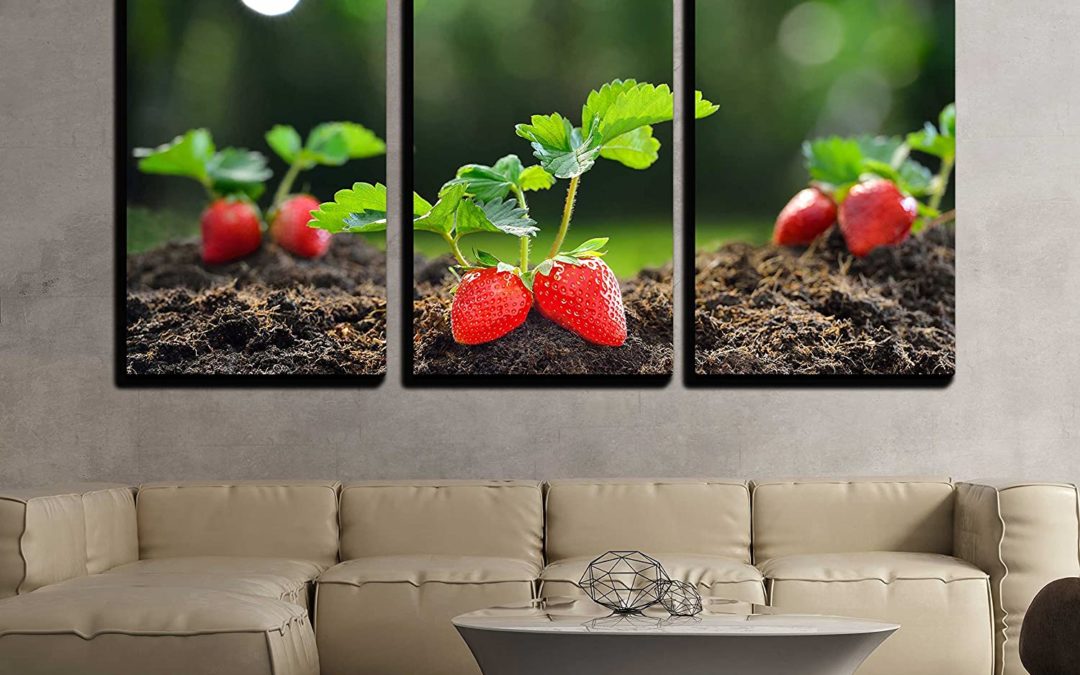Fruits are one of the most delicious foods in nature. Do you happen to have a favorite fruit? Some like the tropical taste of pineapples and mangoes. Others like the tart taste of raspberries. Many really love the exotic flavors of dragon fruit and pomegranate. If you ask us, we’d say the best fruit is the humble strawberry! Undeniably the most popular of the berries, strawberries are rich in vitamin C and manganese. Strawberries are lauded for their characteristic fresh aroma, bright red color, juicy and firm texture and sugary sweetness! Strawberries are consumed in large quantities throughout the world, and are cultivated for fresh eating for for use in processed foods like jam, juice, pies, ice cream, yogurt or milkshakes. Strawberries are even so popular that they’ve been converted into artificial flavorings and scents for things like candy, soap, perfume and lip balm! Do you want to know more about the strawberry? If so, read below for some great strawberry wall art facts!
History

Did you know that the very first strawberry garden was grown in Brittany, France during the 18th century? Before this, wild strawberries were the most common source of this fruit. Wild strawberries were first mentioned in documentation in ancient Roman literature; back then, they were often used for medical use instead of being eaten. During the 14th century, French royalty had wild strawberries taken from fields and planted in royal gardens. During this time period, strawberries saw wider usage and became wildly popular amongst people in all social classes. By the 16th and 17th centuries, strawberries were a common part of life. Read below for more strawberry wall art facts.
Crops
Strawberry cultivars vary widely in every category. Strawberry fields are filled with berries that differ in size, color, shape and texture. The majority of strawberries, including the ones that you eat, are cultivated with a process called the “plasticulture system.” In this system, raised plant beds are formed each year which are then fumigated and covered with plastic to prevent weed growth. Plants are planted through holes punched in the plastic covering, with irrigation tubs placed underneath the plastic. At the end of the harvesting season, the plastic covering is removed and the plants are plowed into the ground. If you’re wondering why, it’s because strawberry plants that are older than a year produce lower quality fruit. With this way of replacing plants, farms get better yields. Read below for more strawberry wall art facts.
Cultivation

Strawberries are notable for being rather easy to grow in most climates and environments around the world. The best time to plant strawberries is during the late summer or spring. Strawberries should be planted while exposed in full sun or slight shade, and in sandy soil. The addition of manure and some type of fertilizer aids in the growing process as well. Alternatively, strawberries grow well in pots or planters with compost. Strawberries have the ability to survive in most weather conditions, but it’s important that the plant always has access to moisture. Additionally, strawberries need some type of protection against slugs and snails which are attracted to the scent of the ripe fruit. Read below for more strawberry wall art facts.
Pests
As previously mentioned, slugs and snails are only two types of pests that prey on ripe strawberries. That said, there are actually around 200 species of pests that are known to attack this fruit! These pests include moths, fruit flies, strawberry root weevils, sap beetles, mites and aphids. Did you know that prior to forming cocoons, caterpillars also favor feeding on strawberry plants? Strawberry pests are so prevalent, that the amount of pesticides needed for the fruit number in hundreds of pounds per acre! The amount of pesticides necessary to protect strawberries has unfortunately led to the strawberry being ranked as one of the most pesticide-contaminated forms of produce on Earth. Don’t worry though, strawberries are still very much edible. Read below for more strawberry wall art facts.
Harvesting

Strawberry plants, like most other commercially farmed foods, are fed with artificial fertilizers before and after harvesting. In order to ensure the fruit qual9ity, berries are harvested every other day. Strawberries are always picked with the green caps still attached and, usually, an inch of stem left. Strawberries must remain on the plant for as long as possible, since they don’t continue to ripen once they’ve been picked. Rotten and overripe strawberries are removed from plants in order to reduce insects and plant disease. Over time, the harvesting and cleaning process of strawberries hasn’t changed much. Strawberries are still harvested by hand and grading and packing occurs in the farm fields, rather than in a commercial processing building. Read below for more strawberry wall art facts.
Conclusion
In addition to being consumed fresh, strawberries can be frozen, “pickled” and made into jam or preserves or even dried and used in something like cereal. Strawberry remains one of the most popular flavoring for dairy products, and is often found in milk, ice cream, shakes and yogurts. Now that you know so much about strawberries, do you think you’ll pick up some from the market tonight? Why not make a delicious strawberry banana smoothie? How about a classic preparation of strawberries and cream? Whatever you do, we hope you enjoyed reading these strawberry wall art facts!

